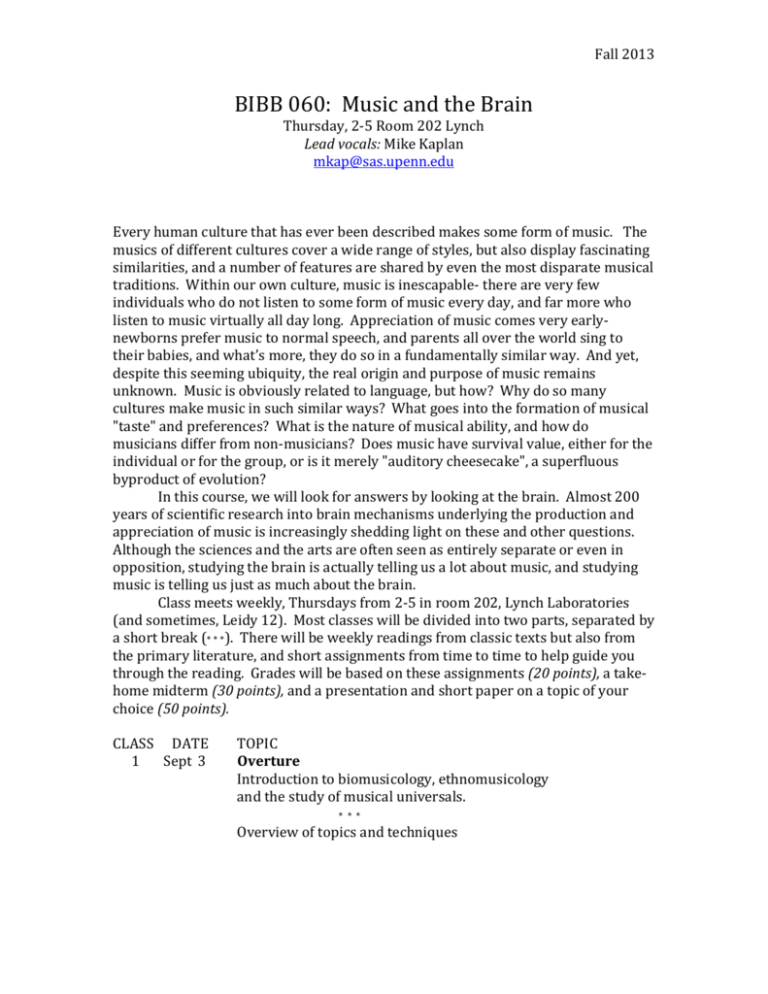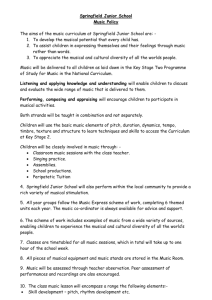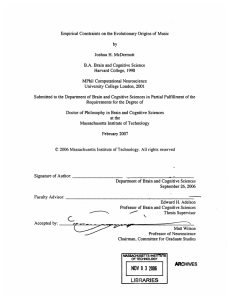MUSIC 2013C SYLLABUS - School of Arts & Sciences
advertisement

Fall 2013 BIBB 060: Music and the Brain Thursday, 2-5 Room 202 Lynch Lead vocals: Mike Kaplan mkap@sas.upenn.edu Every human culture that has ever been described makes some form of music. The musics of different cultures cover a wide range of styles, but also display fascinating similarities, and a number of features are shared by even the most disparate musical traditions. Within our own culture, music is inescapable- there are very few individuals who do not listen to some form of music every day, and far more who listen to music virtually all day long. Appreciation of music comes very earlynewborns prefer music to normal speech, and parents all over the world sing to their babies, and what’s more, they do so in a fundamentally similar way. And yet, despite this seeming ubiquity, the real origin and purpose of music remains unknown. Music is obviously related to language, but how? Why do so many cultures make music in such similar ways? What goes into the formation of musical "taste" and preferences? What is the nature of musical ability, and how do musicians differ from non-musicians? Does music have survival value, either for the individual or for the group, or is it merely "auditory cheesecake", a superfluous byproduct of evolution? In this course, we will look for answers by looking at the brain. Almost 200 years of scientific research into brain mechanisms underlying the production and appreciation of music is increasingly shedding light on these and other questions. Although the sciences and the arts are often seen as entirely separate or even in opposition, studying the brain is actually telling us a lot about music, and studying music is telling us just as much about the brain. Class meets weekly, Thursdays from 2-5 in room 202, Lynch Laboratories (and sometimes, Leidy 12). Most classes will be divided into two parts, separated by a short break (* * *). There will be weekly readings from classic texts but also from the primary literature, and short assignments from time to time to help guide you through the reading. Grades will be based on these assignments (20 points), a takehome midterm (30 points), and a presentation and short paper on a topic of your choice (50 points). CLASS DATE 1 Sept 3 TOPIC Overture Introduction to biomusicology, ethnomusicology and the study of musical universals. * * * Overview of topics and techniques Fall 2013 CLASS 2 DATE Sept 10 TOPIC Musical universals (and near-universals) II Reading: (Peretz, 2006) Optional readings: (Nettl, 2000), (Brown and Jordania, 2011) Musical universals, part II: listening for musical universals * * * Intro to neurons, part 1: Cajal and the neuron doctrine 3 Sept 17 Developmental neuromusicology: Reading: (Trehub, 2003) The musical predispositions of infants Discussion: predispositions, or early learning? * * * Guest speaker: Melanie Cedrone, Biomedical library specialist Using Pubmed, Psychinfo, and Scopus Intro to neurons, part 2: the resting potential 4 Sept 24 From sound to brain Reading: Chapters 2 and 3 (Pierce, 1992) Intro to neurons, part 3: the action potential Lab: neuron demo in Leidy 12 * * * Sound, strings and standing waves The ear (and especially, the cochlea) 5 Oct 1 Pitch and periodicity Reading: (McDermott and Oxenham, 2008, ) (Loui et al., 2010).; optional reading: (Bendor and Wang, 2006) (Zatorre, 2003),. Pitch salience and relative pitch Lab exercise: analysis of sounds with and without pitch * * * Absolute pitch 6 Oct 8 Consonance and dissonance Reading: Chapter 5 in (Pierce, 1992); (Tramo et al., 2001) Historical perspective: Pythagoras, Galileo and Newton Helmholtz, beating and “roughness” * * * Search for and research topics for final projects Fall 2013 7 Oct 15 Consonance and dissonance 2: consonance = harmonicity? Reading: Chapter 6 in (Pierce, 1992); (McDermott et al., 2010); (Cousineau et al., 2012) Consonance, harmonicity and tonal fusion * * * Lab: sound spectra part II- intervals Discuss final projects 8 Oct 22 Scales (or, Pythagoras n’ me): Reading: Chapter 4 in (Pierce, 1992); Chapter 10 (Deutsch, 1999) 9 Oct 29 Comparative approaches: the music (?) of animals Readings: Chapters 4 and 5, excerpts (Brown et al., 2000) (McDermott and Hauser, 2007) Song learning and performance in zebra finches Special guest vocalist: Dr. Marc Schmidt, Department of Biology * * * Comparative approaches: do animals make music? For classes 10-14 the second half of class will be used for student presentations 10 Nov 5 Music, language, and laterality: Reading: (Patel, 2003) (Koelsch, 2005) 11 Nov 19 Music, language, and laterality, part 2: The conversation continues. Reading: T.B.A. 12 Nov 19 Music and emotion: Readings: (Blood et al., 1999) (Menon and Levitin, 2005) (Salimpoor et al., 2011) 13 Nov 26 TBA class left blank to allow for wiggle room in the syllabus 14 Dec 3 Finale: recap of major themes Evolution and origin of music Reading: (Brown, 2003) Fall 2013 REFERENCES Bendor D, Wang X (2006) Cortical representations of pitch in monkeys and humans. Curr Opin Neurobiol 16:391-399. Blood AJ, Zatorre RJ, Bermudez P, Evans AC (1999) Emotional responses to pleasant and unpleasant music correlate with activity in paralimbic brain regions. Nat Neurosci 2:382-387. Brown S (2003) Biomusicology, and three biological paradoxes about music. Bulletin of Psychology and the Arts 15-17. Brown S, Jordania J (2011) Universals in the world's musics. Psychology of Music 40:1-20. Brown S, Merker B, Wallin NL (2000) The origins of music. Cambridge, Mass.: MIT Press. Cousineau M, McDermott JH, Peretz I (2012) The basis of musical consonance as revealed by congenital amusia. Proc Natl Acad Sci U S A 109:19858-19863. Koelsch S (2005) Neural substrates of processing syntax and semantics in music. Curr Opin Neurobiol 15:207-212. Loui P, Li HC, Hohmann A, Schlaug G (2010) Enhanced cortical connectivity in absolute pitch musicians: a model for local hyperconnectivity. J Cogn Neurosci 23:1015-1026. McDermott J, Hauser MD (2007) Nonhuman primates prefer slow tempos but dislike music overall. Cognition 104:654-668. McDermott JH, Lehr AJ, Oxenham AJ (2010) Individual differences reveal the basis of consonance. Curr Biol 20:1035-1041. McDermott JH, Oxenham AJ (2008) Music perception, pitch, and the auditory system. Curr Opin Neurobiol 18:452-463. Menon V, Levitin DJ (2005) The rewards of music listening: response and physiological connectivity of the mesolimbic system. Neuroimage 28:175-184. Nettl B (2000) An ethnomusicologist contemplates universals in musical sound and musical culture. In: The Origins of Music(Wallin, N. L. et al., eds), pp 463479 Cambridge, MA: MIT Press. Fall 2013 Patel AD (2003) Language, music, syntax and the brain. Nat Neurosci 6:674-681. Peretz I (2006) The nature of music from a biological perspective. Cognition 100:1-32. Pierce JR (1992) The science of musical sound. New York: Freeman. Salimpoor VN, Benovoy M, Larcher K, Dagher A, Zatorre RJ (2011) Anatomically distinct dopamine release during anticipation and experience of peak emotion to music. Nat Neurosci 14:257-262. Tramo MJ, Cariani PA, Delgutte B, Braida LD (2001) Neurobiological foundations for the theory of harmony in western tonal music. Ann N Y Acad Sci 930:92-116. Trehub SE (2003) The developmental origins of musicality. Nat Neurosci 6:669673. Zatorre RJ (2003) Absolute pitch: a model for understanding the influence of genes and development on neural and cognitive function. Nat Neurosci 6:692695.






